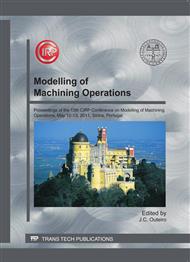p.632
p.642
p.652
p.662
p.671
p.679
p.691
p.701
p.713
Modeling and Analysis Effects of Material Removal on Machining Dynamics in Milling of Thin-Walled Workpiece
Abstract:
In aerospace industry, thin-walled workpieces are widely used in order to reduce the weight and to fulfill the high demands of their later applications. These workpieces are usually highly sophisticated and difficult to machine according to their geometry and material choice. In this paper, influence of material removal within the thin-walled workpiece machining operation on the dynamic properties of the workpiece and the machining process system is discussed. Aiming at learning about dynamic properties evolution during the machining operation, different milling processes of thin-walled plate are studied. Numerical simulation methods are employed in the study to investigate the dynamic properties evolution and machining stability with the material removal process in the milling process of thin-walled workpiece. The investigation results are expected to be used for designing optimized material removal sequence, which will guarantee highly material removal rate as well as highly machining accuracy of thin-walled workpiece.
Info:
Periodical:
Pages:
671-678
Citation:
Online since:
April 2011
Authors:
Keywords:
Price:
Сopyright:
© 2011 Trans Tech Publications Ltd. All Rights Reserved
Share:
Citation:


